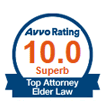Social Security Disability (“SSD”) and Supplemental Security Income (“SSI”) are two programs available from the Social Security Administration (“SSA”) that may play an important role in an elder law practice.
SOCIAL SECURITY DISABILITY (“SSD”) BENEFITS:
Available to a blind or disabled worker who:
- applies for benefits;
- has not reached full retirement age;
- has sufficient social security earnings to be deemed insured for disability;
- is disabled;
- has been disabled for a 5-month waiting period within the last 17 months prior to the month of application. 20 C.F.R. §404.315; 42 U.S.C. §423.
SUPPLEMENTAL SECURITY INCOME (“SSI”) BENEFITS:
Available to an aged (65 or older), blind or disabled individual who:
- applies for SSI and all other benefits for which he/she may be entitled;
- is a U.S. resident or qualified alien;
- is not a resident of a public institution;
- meets the income and resource requirements; and
- is not fleeing to avoid prosecution for a felony or violating probation or parole. 20 C.F.R. §416.202.
“DISABILITY,” DEFINED:
Disability for adults is defined as the inability to engage in “substantial gainful activity” (SGA). There must be a physical or mental impairment, or combination of impairments, that can be expected to last for a continuous period of at least 12 months, or result in death. 20 C.F.R § 416.905.
The Social Security Administration has established certain earnings levels as reasonable signs that a person can perform SGA. As of 2012, that level is $1,010 per month for disabled persons, and $1,690 per month for a blind person. www.ssa.gov/OACT/COLA/sga.html.
If one can potentially earn $1,010 or more (or 1,690 or more if blind), then Social Security presumes that that person is able to engage in SGA. The presumed SGA amount is indexed to an annual cost of living allowance and is adjusted in January of each year.
SOCIAL SECURITY RETIREMENT BENEFITS:
Available to worker who has reached retirement age. The normal retirement age varies, depending on the worker’s birth date, and benefit amount is based upon the worker’s “primary insurance amount (“PIA”)” and the age of the applicant.
SPOUSE/FORMER SPOUSE BENEFITS:
Spouses and former spouses of fully ensured workers are entitled to derivative benefits:
1. OLD AGE BENEFITS:
If an insured worker is alive and receiving benefits, benefits based on the worker’s earnings records are available to the worker’s spouse/former spouse who retires at normal retirement age, or who is otherwise eligible based on his/her status as responsible caregiver of worker’s child.
2. WIDOW’S/WIDOWER’S BENEFITS:
Available to worker’s widow/er based on earnings record of fully insured worker. Benefits are available at the widow/er’s retirement at age 60 or above, or earlier if the widow/er is disabled or responsible caregiver of worker’s child.
CHILDREN’S BENEFITS:
Available to worker’s children, if worker is entitled to retirement/disability benefits, or the worker is deceased and fully insured. Child must be dependent minor child or disabled adult child.
SOCIAL SECURITY AND MEDICARE:
Those age 65 and over who are entitled to Social Security Retirement benefits also qualify for Medicare Part A (hospitalization) benefits. www.socialsecurity.gov/pubs/10043.pdf.
After 24 months of SSD eligibility, individuals who receive SSD are entitled to Medicare Part A, and are eligible for Medicare Part B subject to payment of a premium.
MAJOR DIFFERENCES BETWEEN THE SSD AND SSI PROGRAMS:
- SSD benefits are available only to those with sufficient social security earnings to be deemed “insured” for disability. SSI benefits are not based on insured status or the individual’s earnings. SSI benefits are paid to blind or disabled persons based upon that person’s income and resources.
- Unlike SSD, which is available to those who have not reached the age of retirement, SSI is available not only to the blind and disabled, but also to individuals over age 65.
- In New Jersey, individuals who receive SSI are also automatically entitled to Medicaid benefits.
- After 24 months of SSD eligibility, individuals who receive SSD are entitled to Medicare Part A, and are eligible for Medicare Part B subject to payment of a premium.
INTERPLAY BETWEEN THE SSD AND SSI PROGRAMS:
- An individual may receive benefits under both SSI and SSD, if he/she qualifies for both.
- The standards for the medical determination of disability are the same for the SSI and SSD programs for adults.
- Although an SSI recipient may receive up to $20 per month of unearned income without penalty, any unearned income in excess of $20 per month will be deducted from the SSI benefit on a dollar-for-dollar basis. Benefits received under SSD are considered “unearned income,” and those monthly benefits decrease the amount of SSI benefits to which the individual is entitled, on a dollar-for-dollar basis. POMS SI 00830.050; POMS SI 00830.210. Conceivably, a recipient’s social security benefit could reduce his or her SSI benefit to zero, resulting in a loss of Medicaid benefits.
THE APPEALS PROCESS:
Levels of appeal from an adverse determination:
- Reconsideration: A paper review of the file
- Hearing by an Administrative Law Judge: Hearing, including questioning of witnesses. Most reversals occur at this level.
- Review by the Appeals Council
- Federal Court review
Forms may be obtained online from www.ssa.gov.
THE HEARING:
Outline of Testimony:
- Personal, educational, literacy/fluency, and mental aptitude background
- Work experience
- Impairment(s), including onset date, symptoms, medical sources consulted
- Current treatments
- Physical limitations
- Environmental restrictions
- Psychiatric limitations
- Pain
- Physical Residual Functional Capacity for various activities
- Daily activities of a typical day
- “Before and After” example of limitations
- Medical doctors
- Demonstrations
DETERMINING DISABILITY:
Disability is determined based upon the sequential analysis set forth in 20 C.F.R. §404.1520. According to the sequential analysis,a determination of disability is based upon a five-part analysis of criteria. The first two criteria are as follows:
(1) The claimant is not engaged in “substantial gainful activity” (“SGA”); and
(2) The claimant has a “severe” impairment, which will last at least 12 months (or result in death).
If the claimant satisfies the above two inquiries, the severity of the impairment is then analyzed as follows:
(3) The impairment meets or equals the severity of the listed impairments defined in the medical listing.
If the answer to this question is in the affirmative, then the claimant is disabled, according to medical listing. Otherwise, the inquiry is as follows:
(4) The claimant is unable to perform his/her “past relevant work” (“PRW”); and
(5) The claimant is unable to perform other work within his “residual functional capacity” (“RFC”).
If these latter questions are answered affirmatively, then the claimant is disabled according to vocational factors, even though the claimant has not satisfied the medical listing.
Categories
- Affordable Care Act
- Alzheimer's Disease
- Arbitration
- Attorney Ethics
- Attorneys Fees
- Beneficiary Designations
- Blog Roundup and Highlights
- Blogs and Blogging
- Care Facilities
- Caregivers
- Cemetery
- Collaborative Family Law
- Conservatorships
- Consumer Fraud
- Contempt
- Contracts
- Defamation
- Developmental Disabilities
- Discovery
- Discrimination Laws
- Doctrine of Probable Intent
- Domestic Violence
- Elder Abuse
- Elder Law
- Elective Share
- End-of-Life Decisions
- Estate Administration
- Estate Litigation
- Estate Planning
- Events
- Family Law
- Fiduciary
- Financial Exploitation of the Elderly
- Funeral
- Future of the Legal Profession
- Geriatric Care Managers
- Governmental or Public Benefit Programs
- Guardianship
- Health Issues
- Housing for the Elderly and Disabled
- In Remembrance
- Insolvent Estates
- Institutional Liens
- Insurance
- Interesting New Cases
- Intestacy
- Law Firm News
- Law Firm Videos
- Law Practice Management / Development
- Lawyers and Lawyering
- Legal Capacity or Competancy
- Legal Malpractice
- Legal Rights of the Disabled
- Liens
- Litigation
- Mediation
- Medicaid Appeals
- Medicaid Applications
- Medicaid Planning
- Annuities
- Care Contracts
- Divorce
- Estate Recovery
- Family Part Non-Dissolution Support Orders
- Gifts
- Life Estates
- Loan repayments
- MMMNA
- Promissory Notes
- Qualified Income Trusts
- Spousal Refusal
- Transfers For Reasons Other Than To Qualify For Medicaid
- Transfers to "Caregiver" Child(ren)
- Transfers to Disabled Adult Children
- Trusts
- Undue Hardship Provision
- Multiple-Party Deposit Account Act
- New Cases
- New Laws
- News Briefs
- Newsletters
- Non-Probate Assets
- Nursing Facility Litigation
- Personal Achievements and Awards
- Personal Injury Lawsuits
- Probate
- Punitive Damages
- Reconsideration
- Retirement Benefits
- Reverse Mortgages
- Section 8 Housing
- Settlement of Litigation
- Social Media
- Special Education
- Special Needs Planning
- Surrogate Decision-Making
- Taxation
- Technology
- Texting
- Top Ten
- Trials
- Trustees
- Uncategorized
- Veterans Benefits
- Web Sites and the Internet
- Webinar
- Writing Intended To Be A Will







Vanarelli & Li, LLC on Social Media